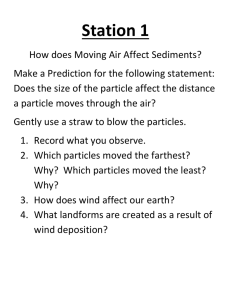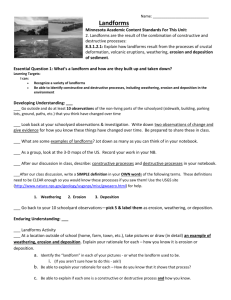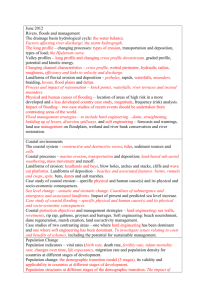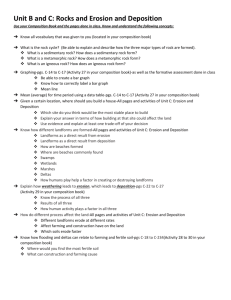Erosion and Deposition Stations 2014
advertisement
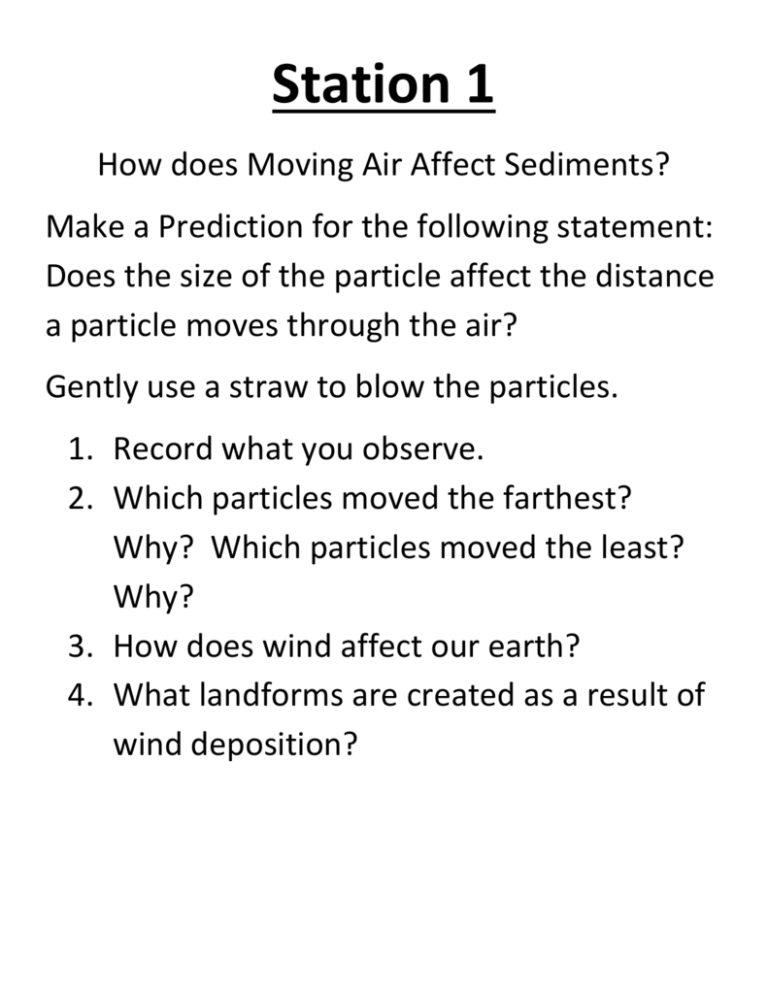
Station 1 How does Moving Air Affect Sediments? Make a Prediction for the following statement: Does the size of the particle affect the distance a particle moves through the air? Gently use a straw to blow the particles. 1. Record what you observe. 2. Which particles moved the farthest? Why? Which particles moved the least? Why? 3. How does wind affect our earth? 4. What landforms are created as a result of wind deposition? Station 2 How do Glaciers Change the Land? Obtain a “glacier” from your teacher. Take a bar of soap and rub the ice, sand side down, over a bar of soap. 1. Predict what will happen to the soap. 2. Observe what happens to the surface of the soap. 3. Based on your observations how could ice change the surface of the land? 4. What landforms are created as a result of glacial deposition? Station 3 How are Sediments Deposited? 1. Shake the jar for 30 seconds. Then let it set for 2 minutes. 2. Predict the order you think the sediments will be deposited into the jar? Explain why you chose this order. 3. After the sediments have settled what was the order of the contents in the jar? 4. Was your prediction correct? Why or why not. Station 4 How Do Waves Shape Land? 1. Use the Popsicle stick to create waves in the pan. 2. Describe what happened to the beach. 3. How did the waves affect the sand and gravel? 4. How do waves cause erosion and deposition on the shoreline? 5. What landforms are created as a result of wave deposition? Station 5 1. What agent of erosion and deposition created the landforms in Pan A and Pan B. 2. What type of landform is modeled in Pan A, describe how it formed? 3. What type of landform is modeled in Pan B, describe how it formed? 4. How is a delta different from an alluvial fan? Station 6 1. The movement of material downhill under the influence of gravity.________ ____________ 2. What factors affect the rate of mass movement? 3. Match the pictures with the types of mass movements. (Mudflow, Creep, Avalanche, Landslide (slump), and Rock Fall 4. Describe three things that can be done to reduce the effects of erosion on steep slopes. Mass Movements A. B. C. D. E. Station 7 1.The main natural force responsible for mass movements rocks and debris is a. rainwater b. wind c. gravity d. fire 2. Rivers transport sediment to a. drainage basin b. oceans and lakes c. water table d. moraines 3. Sandbars, spits, and barrier islands can be built up by a. glacier b. ocean waves c. wind d. mass wasting 4. A dune is a sand mound built up primarily by a. gravity b. wind c. glaciers d. running water 5. Strong wind can transport large quantities of a. large rocks b. dry sand c. wet sand d. clay 6. A mountain valley carved by a glacier has the shape of a a. U b. bowl c. crescent d. V 7. The first stage in the erosion process is a. deposition b. mass movement c. drainage d. weathering 8. How is deposition part of the erosion process? Name:_____________________________________________Date:____________Pd:________ Standard S6E5 d. and f. Erosion and Deposition Station Rotation Activity Sheet Station 1 Prediction: Does the size of the particle affect the Station 2 Prediction: What will happen to the soap? distance a particle moves through the air? Observations: What happens to the soap? Observation: 1. Which particles moved the farthest? Why? 2. 1. Based on your observations how could ice change the surface of the land? 2. Describe the landforms that are created as a result of glacial deposition? Which particles moved the least? Why? 3. How does wind affect our earth? 4. What landforms are created as a result of wind deposition? Station 3 Prediction: How do you think the sediments will be deposited into the jar? Explain why you chose this order. 1. 2. Station 4 Use the Popsicle stick to create waves in the pan. 1. Describe what happened to the beach. 2. How did the waves affect the sand and gravel? 3. How do waves cause erosion and deposition on the shoreline? 4. What landforms are created as a result of wave deposition? After the sediments have settled what was the order of the contents in the jar? Was your prediction correct? Why or why not. Station 5 Station 6 1. What agent of erosion and deposition created the landforms in Pan A and Pan B. 1. The movement of material downhill under the influence of gravity.________ ____________ 2. What type of landform is modeled in Pan A, describe how it formed? 2. What factors affect the rate of mass movement? 3. Match the pictures with the types of mass movements. (Mudflow, Creep, Avalanche, Landslide (slump), and Rock Fall 3. What type of landform is modeled in Pan B, describe how it formed? a. b. 4. How is a delta different from an alluvial fan? c. d. e. Station 6 4. Describe three things that can be done to reduce the effects of erosion on steep slopes. Station 7 1. 2. 3. 4. 5. 6. 7. 8. How is deposition part of the erosion process?

